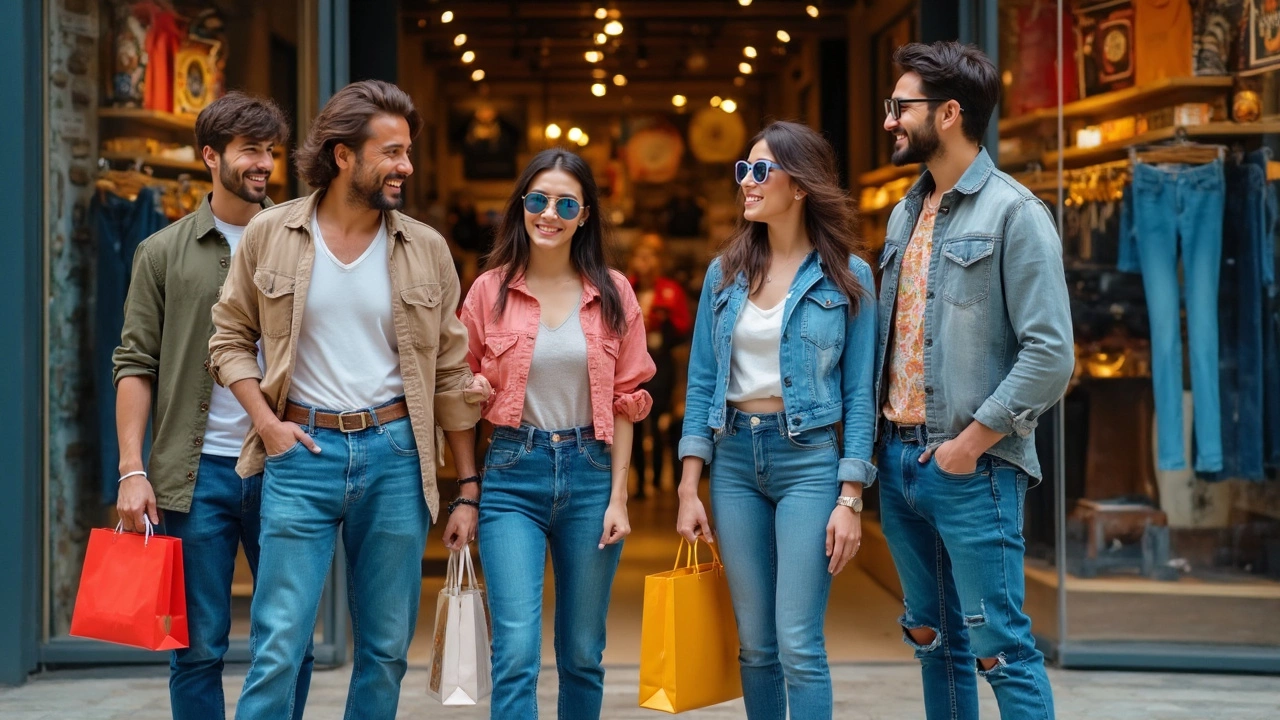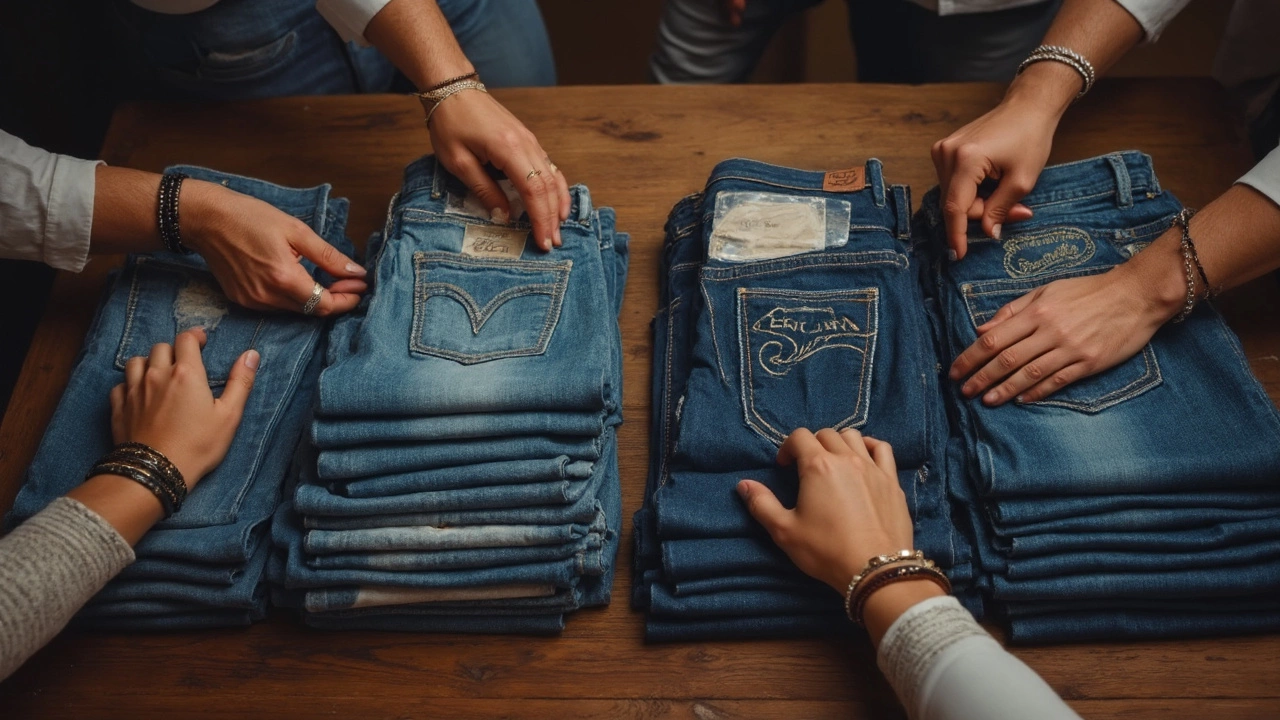Jeans: Which Brand Really Rules?

Ever notice how some jeans just have that 'thing' everyone seems to want? It's not just luck—certain brands totally dominate the denim scene, both in stores and all over social media. And let’s be real: whether you’re chasing a classic look or just need new pants that actually fit, the brand you pick makes a difference.
If you had to name one label everyone connects with jeans, you'd probably say Levi’s. Walk into almost any clothing store anywhere, and boom—there they are. There's a reason for that, and it's not just nostalgia. Levi’s actually invented blue jeans back in the 1870s. It’s wild to think about—what started as workwear is now everywhere, from TikTok to red carpets.
But Levi’s isn’t the only game in town. Some brands focus on trendy fits and eye-popping washes, while others push the envelope with super high-end designer touches. Jeans are one of those things you end up wearing for years, so picking the right brand can save you money and a ton of headaches. Keep an eye out for famous collabs too—sometimes those limited-edition pairs become legit collectibles.
- How Levi's Became the OG
- Other Brands People Swear By
- Designer Denim: Worth the Hype?
- Tips for Finding Your Perfect Pair
How Levi's Became the OG
Levi's isn’t just a household name—they basically set the whole thing off when it comes to jeans. Back in 1873, Levi Strauss, a dry goods merchant, and Jacob Davis, a tailor, got a patent for using metal rivets to reinforce denim pants. This small tweak changed everything. Suddenly, pants held up better. That’s why miners, railroad workers, and gold prospectors reached for Levi’s—they actually lasted.
It’s the jeans brand everybody thinks of first, and the numbers prove it. Levi Strauss & Co. sells over a billion jeans a year worldwide. If you own a pair of 501s, you’re wearing a piece of history. The 501 got its model number in the 1890s, and it’s still a staple today.
What makes Levi’s so resilient? They’ve managed to roll with every trend—the original blue denim, then stone-washing in the ‘80s, skinny fits in the 2000s, now vintage and baggy are big again. Levi’s hasn’t missed a beat. Plus, they’ve made sustainability a focus, using recycled water in denim production and launching programs for old jeans recycling. Here’s how Levi’s has stayed on top:
- They invented riveted denim (think super tough jeans).
- Consistent fits—like the 501—never go out of style.
- Adapting to trends but keeping classics in stock.
- A big push toward eco-friendly production.
- Global reach—Levi’s sells jeans in over 110 countries.
Want to see how Levi’s stacks up? Check out these quick stats:
| Fact | Detail |
|---|---|
| Founded | 1853, San Francisco |
| First Patent | 1873 (riveted jeans) |
| Bestseller | Levi’s 501 jeans |
| Annual Sales (2023) | Approx. 1.1 billion pairs |
| Countries Sold | Over 110 |
The bottom line? If someone’s asking about the OG in jeans, it’s almost always Levi’s. That’s not hype—it’s just years of proof, smart tweaks, and honest quality.
Other Brands People Swear By
Let’s be honest: jeans are everywhere, and while Levi’s gets tons of attention, it’s not the only big player. Some brands have carved out their own fan bases just by doing denim differently. If you want to avoid blending in, these names might be just what your closet needs.
First up, Wrangler. They’re the favorite for folks who want durability—think rodeo-ready, but also stylish enough for city life. Wrangler has been around since 1947 and still claims a big chunk of the market, especially for bootcut or relaxed fits.
Lee is another go-to. Lee took off by making denim affordable and comfy for everyday wear. Their signature Rider jeans were actually the first to feature a zip fly. That's a small thing, but it made life way easier for a lot of people when they launched it in 1926.
Then there are brands like True Religion and Diesel for those who want jeans to turn heads. True Religion exploded in the early 2000s with its bold stitching and horseshoe logos. Diesel’s Italian edge means their styles are trend-forward without getting weird about it—and if you look at what people are actually buying in Europe, Diesel’s numbers have stayed strong for years.
American Eagle deserves a mention, especially if you care about stretch and comfort. Their AE Ne(X)t Level line is super popular with younger teens and college kids. According to the company, about one in three American teens either owns or has owned a pair.
If you’re into the eco-friendly scene, Everlane and Madewell are growing fast. They focus on transparency—Everlane even shows exactly how much it costs to make each pair. Madewell’s jeans are a go-to for curvier fits and tons of wash options.
- Wrangler: Rugged and great for everyday wear, especially classic fits.
- Lee: Affordable, reliable, and a little more forgiving on sizing.
- True Religion: Big on signature stitching, made for standing out.
- Diesel: Euro-cool, lots of fabric choices and fits.
- American Eagle: Flexible and soft, ideal for all-day comfort.
- Everlane & Madewell: Eco-conscious and focused on fit variety.
Here’s a quick breakdown of how some top brands stack up:
| Brand | Founded | Main Selling Point | Average Price Range (USD) |
|---|---|---|---|
| Wrangler | 1947 | Durability, classic style | $30 - $60 |
| Lee | 1889 | Affordable, comfy | $40 - $70 |
| True Religion | 2002 | Designer look, stand-out details | $150 - $300 |
| Diesel | 1978 | Edgy, trend-driven | $150 - $320 |
| American Eagle | 1977 | Soft, stretchy, youth style | $40 - $80 |
| Everlane | 2010 | Eco-friendly, transparency | $78 - $98 |
| Madewell | 2006 | Variety of fits, inclusive sizing | $80 - $140 |
If you’re shopping for jeans, start by thinking about what matters most to you—durability, style, or maybe you just need them to feel good all day. There are brands for every taste, so don’t settle for something that’s just okay.

Designer Denim: Worth the Hype?
The word 'designer' gets tossed around a lot, but what does it really mean when it comes to jeans? Basically, designer denim is made by big-name fashion houses—think Gucci, Balmain, or Diesel—and the prices can get wild. We're talking $200, $400, or way more for a single pair.
So why pay so much? The hype mostly comes from premium fabrics, limited releases, and the sheer status of wearing something with a famous logo. It’s not just about looks; some designer brands use rare selvedge denim, hand stitching, and custom hardware to boost both comfort and longevity. Celebs rocking these brands definitely bumps up the cool factor, and some pairs genuinely increase in value if there’s a lot of buzz.
Check out how some popular designer brands compare on average price and features:
| Brand | Average Price (USD) | Known For |
|---|---|---|
| Gucci | 800+ | Bold designs, iconic branding |
| Balmain | 1000+ | Heavy distressing, standout zippers |
| Diesel | 200–350 | Trendy washes, modern fits |
| True Religion | 200–400 | Super-stylized stitching, celeb fans |
But here’s the real talk: most people don’t need to spend big bucks to get jeans that look and feel great. Sure, designer pairs come with bragging rights, but lots of mid-range brands use great fabric and make killer fits for half the cash. If you do go for a splurge, double-check the care details—dry cleaning some designer jeans isn’t just suggested, it’s required.
- If you care about status and limited drops, designer jeans can be satisfying.
- Looking for solid construction and comfort? You can find those qualities in brands under $150.
- Some resale shops or apps like Depop list lightly worn designer jeans for a fraction of retail.
At the end of the day, the jeans you choose should fit your style, your life, and your wallet. Do your homework, shop smart, and remember: nobody cares about the tag if the fit isn't right.
Tips for Finding Your Perfect Pair
Finding jeans that don’t stress you out in the fitting room is totally possible. You just need to know what actually matters when you shop. The fit comes first—but fabric, wash, and price are right behind.
Size charts are all over the place. A 28 from one brand can feel tighter than a 26 somewhere else. Don’t get hung up on the number—go with what feels good. As Emma Morrison, an editor at Glamour, puts it:
“Don’t be afraid to grab three sizes of the same jeans. There’s no universal sizing, so finding your best fit is about options, not the label.”
If you want jeans that really go the distance, look for a higher cotton percentage, like 98% or more. Stretchy jeans (thanks to elastane or spandex) feel comfy but don’t usually last as long. Darker washes hold up better for dressing up, while lighter ones give that laid-back, vintage vibe.
- Check the rise: High-rise works well for comfort and shaping. Low-rise is trickier—just be sure you like the look.
- Try bending and sitting in the fitting room. If they dig in or feel weird, they’ll only get worse with wear.
- Stick with shapes that match your routine. If you walk or bike a lot, a relaxed or straight leg is easier than skinny jeans.
Here’s a little cheat sheet that shows some basic differences. Just remember: trust your mirror more than the tag.
| Brand | Main Fit Style | Typical Cotton % | Price Range (USD) |
|---|---|---|---|
| Levi's | Straight, Skinny, Bootcut | 98-100% | $50-$120 |
| Wrangler | Relaxed, Tapered | 99-100% | $40-$80 |
| Madewell | High-Rise, Curvy | 90-99% | $80-$150 |
| Diesel | Skinny, Slim | 98-99% | $120-$250 |
One last thing: don’t wash your jeans after every wear. Studies show that washing less keeps the color and stops shrinkage—Levi’s themselves say maybe just spot clean unless they’re truly dirty. Your *jeans* will last longer, and honestly, nobody’s checking how often you do laundry.